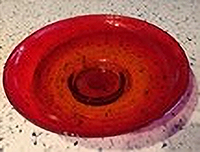Dore Rotundo: Architect and Land Dyke
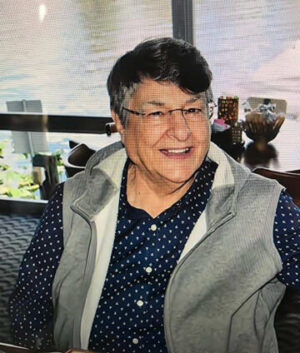
Edited by Marie Steinwachs, Corky Culver, and Kate Ellison. Interview by Rose Norman at Dore Rotundo’s home at the North Forty, in Florida, on March 20, 2016.
Personal Background
I was born 1935, in Utica, New York, in my parents’ bed, without the aid of a physician, though my grandmother was there. I was the third child, coming after a brother and sister. We were living in what would now be considered the Italian ghetto, a poor working neighborhood. You’ve heard of cold-water tenements? That’s what it was like. We didn’t have a bathroom in our apartment, but there was a shared toilet down the hall, and we had cold running water in the kitchen sink. The whole extended family on my father’s side occupied the building; we lived with another family on the third floor.
My mother, of course, wanted to get out of there as fast as she could. Around the beginning of World War II, my father went from factory worker to businessman, owning and running a gas station, He made enough money to move the family out to the white suburbs, where we were immediately recognized as Italians from the poor district who had moved up. I went to Catholic elementary school there, public school, and then to the country high school, where I graduated, about fifteen miles from Utica.
Discovering Architecture
My father had a stroke at a very young age and his health was not getting any better. In 1953, my mother decided to move the family to Florida in hopes the warm weather would help my father. That’s where I discovered architecture. We were visiting St. Petersburg, Florida, just walking around, and I noticed a small museum that was showing architectural work. We went inside, mainly just to get cool. But when I saw those drawings and photographs on the wall, I fell in love with the art of architecture. I decided on the spot to go to the University of Florida and get my degree.
At the time, the University of Florida was charging $75 for tuition and $75 for a dorm room. For $150 a semester I was able to attend college. I wasn’t really a good academic; my grades were average. I was told to see a counselor before going into architecture. He told me I shouldn’t be an architect, but rather an interior designer. I completely ignored that, of course. It was as though I was driven.
Biographical note
Dore Rotundo, born in Utica, New York, in 1935, moved with her family to Florida just after her high school graduation. She attended the University of Florida in Gainesville, where she became famous for being the second woman to gain a degree in architecture at that university in 1960.
Dore began teaching at Gainesville High School because receiving acceptance as a woman architect was difficult. She then took a teaching position at a technology high school in San Francisco, California.Dore was a founding mother of the North Forty womens’ land community in Florida, where she designed three of the houses. Dore also designed the local [Melrose, Florida] library. Loving music, she took part in a women’s singing group as often as possible.
My love for architecture sustained me through a lot of rough periods. I was hardly aware of how I was being treated though, because I was totally focused on learning. That was the only way I could have gotten through, just psychological tunnel vision.
I was the only female architecture student in the three years of upper division courses (of what was then a five-year program). No women ahead of or behind me meant I was both lonely and the focus of unwanted attention. In the entire state of Florida, only the University of Miami and the University of Florida in Gainesville taught architecture then. I didn’t know of any women architecture students in Miami. I doubt there were any at that time.
Another woman had graduated from the University of Florida before I started but I never met her. She was working in St. Augustine, Florida, by then, probably involved in restoration work in that historic city. I don’t remember how I found out about her. I talked to her on the phone, went to her house, and knocked on the door, but she didn’t want to talk to me.
I worked in college when I could, accepted some support from my folks, and graduated in 1960. Then I got married–big mistake. John was a classmate, and I thought we were going to open an office together and do great work. It was an impossible puff dream. He was impossible. He really wanted to go back to college, not go to work.
Meeting Corky
John and I were living in Melrose, Florida, on Little Lake Swan, which was then connected to the larger Lake Swan, where Corky [Culver] was renting a house with a couple of other women. I met her because she needed a ride to Gainesville while her car was being repaired. I was commuting to the city to work. A guy who knew us both flagged me down and asked me to take her into town. At first, I kind of resented it, but by the time we got to where I was working, I realized she was a very interesting person.
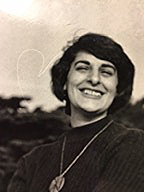
I gave Corky a couple more rides that week. I was becoming really interested in what was going on with her and her friends, and started hanging out with them. They were “out” lesbians, and it wasn’t too long before I started getting the whole picture of what was going on there. I was loving it: falling for Corky and going through a self-discovery I never could have imagined! Remember, this was several years before Stonewall and longer before feminism would re-emerge.
My husband and I were still married but we weren’t together. He was disappearing on weekends, seeing other women . . . and so was I! In early summer of 1965, my husband told me he was interested in another woman, so I said, fine, let’s just quit this. Good-bye. Do well. Corky and I decided to go out to San Francisco, California, together.
Living in San Francisco (1965–68)
I found a job I loved, teaching drafting at John O’Connell High School in San Francisco. We found an apartment in the Potrero Hill area and settled there for three years during the height of the hippie movement and the “Summer of Love.” We enjoyed every moment of it with each other and the steady stream of creative folks coming through. It was a high time of fun and hilarity!
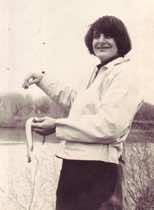
I learned a lot, especially from the diverse bunch of teachers at that vocational school. One teacher, Rudy, had escaped from Hungary during their revolution. After Robert Kennedy was assassinated [June 6, 1968], he came into my drawing classroom, and said, “This is a violent country.” I was taken aback. I had never heard that said before, but I realized he was right. I began to understand the political situation in the United States, our imperialism, and a lot of other bad news stuff.
I went to a couple of marches in Berkeley, California, and observed what was going on. I can’t say I participated; I didn’t have a handle on it. I decided that, although San Francisco was a beautiful place, I missed Florida. I missed the warm water, and even the heat and humidity. We decided to go back there in August 1968.
Returning to Florida
Corky planned to finish her master’s degree at the University of Florida, and I immediately got a job teaching pre-architecture at Santa Fe Community College in Gainesville. We started meeting other women, including Judith Brown [a lawyer] and Carol Giardina*, who were very political and continued our eye-opening political and feminist education.
* Judith Brown was an activist for civil rights in the 60s. She co-authored (with Beverly Jones) the seminal “Towards a Female Liberation Movement” in 1968, which helped launch the national Women’s Liberation Movement. Judith was board member emeritus of the Redstockings, and continued her activism through her law firm until her death in 1991.
Judith and Carol Giardina started Gainesville Women’s Liberation, the first women’s liberation group in the south. Carol was active in civil rights, labor, and Black power movements, and a longtime member of the Redstockings. She started an abortion referral network for women in Florida in 1963, when abortion was illegal in the state. She is a professor at Queens College in New York and author of Freedom for Women: Forging the Women’s Liberation Movement, 1953-1970 (2010).
Buying the Land
Women were coming to realize it was no accident that we didn’t own land, houses, or other things of value, often because credit was hard for women to get. We started a lesbian consciousness-raising group, and from this, several of us decided to buy land together.
We bought forty acres of land in 1972. It was very cheap. We didn’t realize that the land right next to us was the oldest Black community in that part of Florida. It was named after Tom Speed, the great granddaddy of just about everyone living there. More on the land later.
Being an Architect
Most architects come from a family whose uncle or father worked in construction. At the University of Florida, I was one of the few students, along with some Korean War veterans, who didn’t have that background.
Not all the students were interested in architecture. One guy was there on a golf scholarship; I never saw him in class. One day I asked why he was there, and he told me that his father was a contractor and he needed an architect to seal the drawings, which is a requirement in the state of Florida. He didn’t care about architecture, and, of course, he didn’t make it through the first year. In architecture you can’t do that. Every minute of every day is devoted to class work or design work in order to get through. That opened my eyes to the fact that there are professional people who don’t give a damn about their profession.
Nobody would mentor me; I didn’t have that connection with the male architects. I could draw so they thought I would be a draftsman and never pass the state boards.
In architecture, like law, you have to be mentored; you need an internship. Nobody would mentor me; I didn’t have that connection with the male architects. I could draw, so they thought I would be a draftsman and never pass the state boards. I flew back from San Francisco to Gainesville in 1966 and passed the state board exams just fine. After that I did some work on the side while teaching for a regular income. I always had a project on my drawing table.
I worked for two architects in Florida, one in Atlantic Beach and one in Jacksonville. Thank goodness I worked for architects who really did love architecture. Both became quite famous for their work. I hardly made any money working for them, but I gained a lot of experience.
I had designed something for a big firm in Jacksonville, but they didn’t want me to go out to the site to see it. I worked in the design department, and I knew I needed to go into the working drawing department to see the specifications. They said, no, you’ll be a distraction. What craziness was this? They didn’t want me to leave the design room, which was very small, but that’s where all the brain work was done. Hitting a wall, it became very obvious that I was not going to get my license if I depended on the architects I worked for. So I started going to building sites on my own.
Working for architects, I would be hired to work on a project, and when it ended, so would the job; I would have to hunt for another one on my own. The guys working for architects tended to get passed from one office to another, so they got known. Not me. I managed to find work because I wasn’t asking for much money. One architect in Gainesville, whose work I really liked, yanked his weenie out and chased me around the drafting board one day. That’s when I decided I wasn’t going to work for any architect but myself. I went into teaching and found out I loved it.
Teaching at Santa Fe Community College in Gainesville, Florida
They hadn’t built the school yet when I started working at Santa Fe Community College. One of the reasons they wanted me to teach there was because I was a registered architect. I would take their existing buildings and modify them for classes. We had a downtown high school, an industrial building out in the woods somewhere, the elegant old Hotel Thomas, and two or three other shacky things. We were trying to work with those while the architects from New York or somewhere were designing the new campus. Meanwhile, I was designing the buildings I would work in. I got to design my drafting room just the way I wanted it. An entire wall was corkboard; the other two sides were glass. Then there was a workroom.
There were no women students in vocational courses until I started teaching at Santa Fe. I had a whole passel of students who wanted to bribe me, flirt with me, take me out, and cheat!
At Santa Fe, I began teaching drawing, pre-architecture, pre-engineering, machine drafting, surveying, and materials of construction. I had 25 different courses that I had figured out how to teach, but I had to get enough students into the program before I could teach them. They wouldn’t allow you to start a program until you had enough students to fill it. I developed the drafting program and the pre-construction program (which I hired a man to teach it) and started the graphic arts program, finding someone to teach that, too.
There were no women students in vocational courses until I started teaching at Santa Fe. I had a whole passel of students who wanted to bribe me, flirt with me, take me out, give me things. And cheat!
I wanted them to learn the process, going from the drawing paper to the reproduced set of drawings. I had a machine in the work room that would make blueprints. After the project was over, they would put the blueprints on the wall. Some students took drawings done by other people, ran prints of them, and put them on the wall. I’ve never seen anything so despicable in my entire life. I pointed out to the class that these prints were all the same. I told them everybody was flunking. “Until you can put your own work up here, you’re not passing this class.”
They told the department head about it, but, of course, he didn’t care. It was the first school I ever knew about that didn’t have a failing grade. If they didn’t pass, they could keep taking a class until they did. I liked that. The other faculty didn’t, and eventually they changed it. That was the first group of students I didn’t like, all very wealthy and privileged. They didn’t do anything. They had a good time while they were there, and they got their degrees.
When you’re teaching vocational subjects, the higher-ups don’t want to see you. They lumped all my subjects together with vocational stuff. I was at Santa Fe eleven years (1968 -1979), and I never had an administrator come to my classroom.
No one ever told me I was doing a good job. A student told me that my two or three drafting courses were the only ones in the state that the University of Florida would accept in their architecture program. I felt really good about that. I just kept going. Santa Fe is now a four-year college and one of the best in the country. It had a great start with wonderful people teaching there and some very creative minds at work. It was a pleasure working there most of the time.
Another High School Experience
I taught for a year in the vocational drafting area at Gainesville High School. They called it “Industrial Arts,” but I always made it into architectural drawing. I’d have six kids in the morning, six in the afternoon, all boys, of course, and all hated school. They were the best kids! They were so creative and imaginative.
My approach was always professional. You started out teaching the basics, but then you move to an office structure and allowed them to do their own designs. Boy, they loved it! They really ate that up. I ran a very open classroom. If they wanted to go outside and get a cigarette, I didn’t care, as long as they did their work. I respected them, and they respected me.
I stopped looking for praise from anybody, because it’s wasn’t ever there. The only guy who said anything good was the principal at John O’Connell in San Francisco, who said “We always lose the good ones. The good ones never stay long.”
Starting the North Forty
I was teaching at Santa Fe when we bought the women’s land now known as the North Forty. A class of surveying students came out and surveyed the property, sort of. I plotted it out so that we would have eight two-acre lots, some of them touching. There would be circulation of common land all around. That’s why you get this feeling of being surrounded by woods.
We wanted to set up a way to limit buyers to other lesbians that we wanted to be in community with. We found out from the lawyer that in this country you can’t limit anybody’s right to sell property. That’s why all these different dyke lands arrange different ways to control ownership. We went right to being a land holding corporation. We became shareholders in the corporation, each with control of two acres, and the rest of the land held in common.
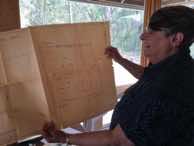
We had eight lots, but we had a lot more than eight women interested [in buying in]. At one time, I think we had twenty-two. They dropped in and out fairly regularly. One of the agreements was that if you left you could not get any money back. We had no money to give back. We didn’t have much money to start with, and we were paying a mortgage on the land. On the other hand, a lot of our members weren’t working regularly and couldn’t make regular payments. When they did work, they tried to catch up. Nobody ever said, “You owe money.” When we needed to make a payment, one of us had the money. We kept detailed books and knew where the money was coming from and where it was going. If someone wanted to see the books, they were open. They could see how much each owed.
The first night we slept out on the land was Easter weekend. Some guys drove up our road, which was just a path then. They probably had not known of the recent land sale. I just happened to be walking around the area with Corky, who had a flashlight. She was saying, “You know, you can use this just like a weapon. If anybody comes up, you just shine it in their face, and they can’t see you. It puts them on the defensive.” As we’re walking around talking, about six guys got out of a car and started asking what we’re doing.
She did exactly what she said she would, shined the light on them and said, “We own this property. What are you doing here?” They got in the car and left! I was totally amazed. We had a few little problems after that with teenagers and theft, but not much.
For a long time, nothing much was happening with the land. In the meantime, Corky left for a while, and Pat Paul came into our realm. It’s like a pond, where lesbians go round and round. We’ve all slept with each other, enjoyed it, and played music together. Pat moved there, living in a very small trailer with no running water, no electricity. Yet she went to work every day as a professional, usually as an x-ray technician.
The first house we built on the land was a small one, nestled near the center of the property. It was my design, of course, simple and functional. It was post and beam construction using local cypress, and put together with bolts. We could put up the column and pre-drill where we would secure the beams. A couple of women would hold them up and we’d add the bolts. It was like magic! The structure was coming together. I put plywood on the corners to stabilize it.
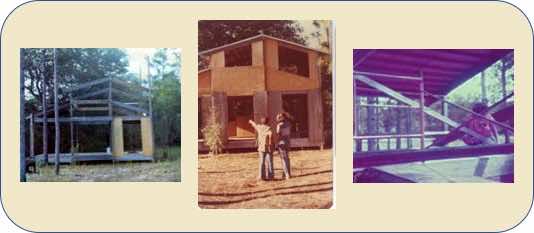
What I had in mind was to teach women the basics about structure, how materials go together, and the tools that you need. There was no electricity out here, no water. We had to do everything with hand tools, which was fine with me. We had Maxine, an old forestry truck I bought for $500.
A lot of women would come through, ask questions, and want to do some drilling. It took a lot of drilling by hand. Thinking about it now, I don’t know what kept me going. I was living [in a log cabin] on a nearby lake, and had very little intention of living on the North Forty. But it was bigger than that, bigger than my wanting to live there. It was a movement; I could feel that movement and the need for women to understand things and acquire skills that had never been available to us, but weren’t that complicated.
Hosting Lesbians Empowered for Activism and Politics (LEAP)
In 1984 and 1985, the North Forty was the location for a conference we called LEAP, Lesbians Empowered for Activism and Politics. It was an amazing accomplishment, really, bringing about 250 lesbians from all over to undeveloped land for a weekend of camping, music and workshops. By then, we had running water, electricity, and a few women living on the land. For the gathering, though, we had to install outdoor showers, outhouses, and a stage. We marked off and built pathways that protected the patches of deer moss and gopher tortoise holes.
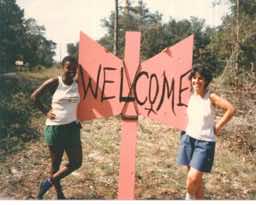
Getting Somewhat Organized
In retrospect, we did some really smart things in regards to the land. We set up a corporation called a holding company, which is usually used to retain control of a small family business. On the North Forty, members have “life estates.” Our individual two-acre lots are surveyed, then we are individually taxed for the lot we control. The remaining twenty-eight acres are taxed to the corporation.
Members pay quarterly fees to the North Forty to cover taxes, liability insurance on the common area, and maintenance of roads, paths, and fences. We got the insurance almost immediately. We have had lots of women coming through the land and it’s full of things that can hurt you. It’s the woods!
We were too open, with too much booze, too much dope, too much fun, too much being in love, playing music.
The problem now is that all of us are aging, even if we are in fairly good health. But we are not going to be here forever. If I left, my house would be expensive for the North Forty to maintain. I can’t sell it on the open market, since it is part of community. I own the house but not the land. Banks don’t offer mortgages on life estates. It’s a real dilemma.
If you count the first house, I designed and oversaw the construction of three houses on this land. When we built that first house, the goal wasn’t to have a house, but to teach others how to build a pole (post and beam ) house, simple construction. I never taught formalized classes, although I thought about it, having women come out at a certain time and so on. But we were just not like that. We were too open, with too much booze, too much dope, too much fun, too much being in love, playing music. Some women had day jobs. The constructon work was just catch-as-catch-can.
To get it to where I left it—which was just a shell—probably took a couple of years, working three or four hours on a weekend. Then Corky bought it from me and put in enough work and money (like interior walls, water and electric) to make it livable. She lived there a few years before buying a cabin on Lake Swan. She rented out the North Forty house two or three times, and each time had to get members’ approval of her renter, which could be a bruising experience. Later, Shan became a member and bought the house from Corky.
I designed Pat’s house, too, which she loves. It’s a lot smaller than mine, but it’s beautiful, with huge windows and an outdoor feel. It was built a little at a time over the years as she saved up for it. Women contributed to help her along. I bought her a bunch of windows and a sliding glass door. She painted and did whatever she could do.
Finding Martha
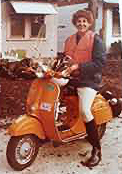
In 1979, I met Martha [Strozier]. She showed up one day to help with a small house we were building. Later, I found out that she would like to see more of me. I thought she was kind of straight, and I knew she didn’t live in Melrose, but then I heard she bought a cottage at the Pagoda [a lesbian community in St. Augustine, Florida], and I realized, “Oh! Wow! She is a lesbian, or definitely wants to be!” Later she bought me a Pagoda cottage. Turns out she came from money in Savannah, Georgia, and her father gave both of his daughters whatever they asked for. Of course, when he died, she inherited a lot of money, so we had the opportunity to do some interesting things together.
I was living in a 1930s log cabin on Lake Swan that I held onto for 20 years, until 1991 or 92. I had a couple of sailboats. I loved it. Martha and I also built a gorgeous house on fifteen acres near St. Augustine, with a pond, room for me to garden in the bottomland, and a horse for Martha. It was built in what I call my country cottage style, all wood, sheet metal roof. It’s built off-grade, with natural wood. Big decks. Big overhangs. The windows never get rained on; water never touches the wood. It’s a good design, really. I incorporated that with some of the materials that they used in Florida years ago, a lot of cypress and other natural wood.
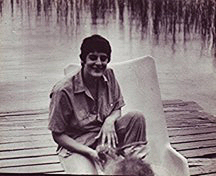
Setback
I got really ill at the end of 1990, the beginning of 1991, when we lived in St. Augustine. When I first got sick, I went to a doctor and was told I had a cold. That was worse than no advice at all! I became delirious from a high fever, but I didn’t realize how sick I was. I kept getting sicker and sicker. Finally, a friend of mine said, “Dore, I have this appointment for tomorrow with a homeopath, who was also a medical doctor, in Jacksonville. Why don’t you take it?” I wasn’t in his office five minutes when he decided to take a blood sample. The next day, he called Martha and said, “Get her to a hospital right now.”
I was in the hospital for sixteen days. They thought I was a goner. The results of the blood test had come back saying I had a viral or bacterial infection (they never knew which). They said they put it in a Petri dish and killed it as soon as I came in. What they knew about was antibiotics, so they stuffed me with antibiotics for three months. Three months! That’s the medical condition of the country. I sold the log cabin to pay for some of my medical bills, which amounted to about $150,000, a lot of money back in the early ‘90s. I inherited some money after my sister and mother passed away and most of that also went to the hospital to pay off those bills.
After I recovered, Martha decided to buy a 40-foot RV [recreational vehicle]. We started touring the country in the summer, avoiding the southern heat. We had that St. Augustine house and a lot of acreage that needed care while we weren’t there. We decided we had to sell it. I couldn’t live in an RV forever, so that’s how I came to build the house on the North Forty, using some of the money from the sale of the big house. Then came menopause, with terrible hot flashes every fifteen minutes. I couldn’t work, couldn’t do anything. I needed to get out of hot Florida summers. We went to Colorado, Alaska, and up to Seattle, Washington, where my nephew B.J. lives with his family.
The Long Commute
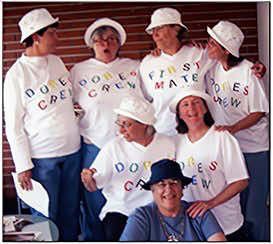
After leaving Seattle, we found Long Beach peninsula in Washington on our way down the coast. It was 72 degrees, with ocean breezes—like heaven in the summertime. The next summer we left Florida and returned to Long Beach. The third summer we bought a house out there and remodeled it. We settled into a routine for a decade or so, staying at the North Forty for the winter, traveling to Washington state every summer.
The Long Beach house was two blocks from the Pacific Ocean. We got a small stream of visitors every summer while we were there. For my 75th birthday, many of my Florida friends came to visit and celebrate.
In 2013, when gay marriage became legal in Washington State, Martha and I tied the knot. It wasn’t the romance, after all these years; it was the financial safety, and the fact that our love and dedication over all these years could finally be recognized by the state.
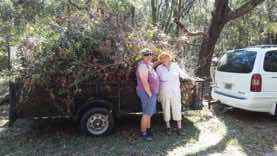
Every year when fall came, bringing gale force wind and driving rain, we would come back to Florida. Having that RV meant we could explore nearly all the national parks and plenty of state parks as well. Martha was in her element when we were on the road. Eventually, though, the travelling was too much for us as octogenarians and we had to let it go.
Rose Norman interviewed Dore Rotundo at her home on the North Forty, outside of Melrose, FL, on March 20, 2016, and prepared this excerpt. Edited and updated for continuity by Kate Ellison and Marie Steinwachs, Dec. 2021, with additional memories from her friends Kate Ellison, Corky Culver, and Martha Strozier.
Postscript
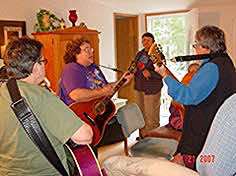
Since this interview was completed, much has changed. After settling down at the North Forty, Martha’s love of travel took them both away a couple times a year for cruises to interesting places: Antarctica by way of the Galapagos Islands and Iceland by way of Denmark and Sweden, for example. Dore was just as happy during the times they would stay home, play music with friends, and grow a garden.
Settling in soon turned to moving again. In 2019, Dore came back from a cruise with something wrong. She ended up in the hospital several times over the next few months. She had probably suffered a mild stroke and seemed not to be getting better. Martha put them on a waiting list for a senior living cottage in Gainesville. A cottage opened up almost immediately and they were gone again, hastily moving so they could be closer to doctors and hospitals. In 2020, Dore was diagnosed with cancer and an inoperable blockage in her heart. Dore Rotundo died on August 15, 2021, after about 6 months in hospice.
Utica
By Dore RotundoUtica was built in 1775, so it had some of the oldest building in the country, and they were magnificent. Being raised in and around there until I was 18, I was exposed to these buildings and very impressed by them. I loved walking around and looking at the buildings. They’re still there, too.
It was an industrial city: Utica sheets, Utica club beer, rayon factories, cotton factories. Very working class. But in every city, there’s an upper class, and they had buildings built that were pretty awesome. The Stanley Theatre was magnificent. It’s still there. They preserved it.
Architecture
By Dore RotundoI had been painting, drawing, doing graphics in high school. The thing about architecture, though, that really got to me was I felt that architecture was an art you could move through. You could walk through the art and see it from different angles, whereas a painting is two-dimensional. You stand in front of it and look. You do not interact with that painting except visually, and maybe emotionally. In architecture, you actually walk through the art. That really got to me.
So, I left painting behind. Occasionally, I’ll do a painting. I also like working with clients. You have to have a personality that loves being alone for the design work, and loves being with people when you’re working with clients, doing the client interviews, finding the architectural program. I liked both sides of that.
Remembering Life in San Francisco
By Corky Culver
We were in San Francisco at the time of the first Fillmore concerts, the love-ins, the free concerts in Golden Gate Park by the Grateful Dead. Friends of ours usually headlined at the Drinking Gourd in the Marina on Saturday nights — great folk music. Other weekends we headed out for nearby wonders like Tomales Bay, Muir woods, and Point Reyes.
One weekend we went to Yosemite, not realizing that the temperate weather of San Francisco didn’t extend very far. We pulled the van into an oddly empty camp ground and had to drive up and down the park road with the car heater on to get warm. When we woke up, we saw we were parked facing a lake partly iced over. Not only that, our usual method of rolling the van down a hill and popping the clutch (having no working starter), was going to be quite dicey, since the lake was nearby and the car very, very cold. We made it, but just barely.
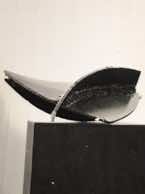
During that time, Dore and Charlie and I started an art gallery on Guerrero Street, a pleasant location on a boulevard not far from Market Street. Charlie was a friend and fellow teacher at the Vocational school. He had been noting some interesting pieces thrown out by the welding class. We all agreed the pieces often showed a kind of creative focus where the students tried various shapes and sorts of welds. We rescued them from the alley
A wild notion came to us. Let’s do a showing at a gallery of a group of these. Yes, and then to show them as art in an elegant setting they deserved, we found a storefront we could open and to turn into a gallery. Many happy days followed, scrubbing, painting, laying an emerald carpet, creating panels to divide the room into nooks with each piece getting a setting on a pedestal with its own careful lighting and perhaps some accompanying sprigs of bamboo, pebbles, and such. We thought of other artists’ work to follow.
The opening show of the Found Art attracted a San Francisco State art department class and an article in the San Francisco Chronicle. We were launched! The gallery presented artist friends and friends of friends, each making some sales and adding to their experience and resume. Plus, each opening involved an oak cask wrapped in vines and flowers and lots of wine-drinking long into the night and cushions on the floor.
I was Dore’s housekeeper as I worked on my poetry and my master’s thesis. She announced “you don’t keep house like my mother”. True that. But I did learn to cook and served us some fabulous meals, gathering fresh food from tiny stores, specialty shops, and markets on Mission Street that sold varieties of seeds, nuts, and new foods to try. Sometimes I would bring a crab and sourdough bread from the wharf.
One of my presentations became a favorite story. The “Crème de la Crème,” presented in a gorgeous shallow ruby red bowl. It took hours to create its many jelled and creamed and fruited layers, waiting in the fridge for final assembly. Irma Rombauer (The Joy of Cooking) guided me step by step. As I carried my tall creation to the dinner party and set it on the table, praise, awe and applause ensued. Then, before our horrified eyes, it began very slowly and steadily to collapse, first oozing over the edge of the bowl, then flowing briskly across the table.
When Dore died, she left me the beloved bowl.
